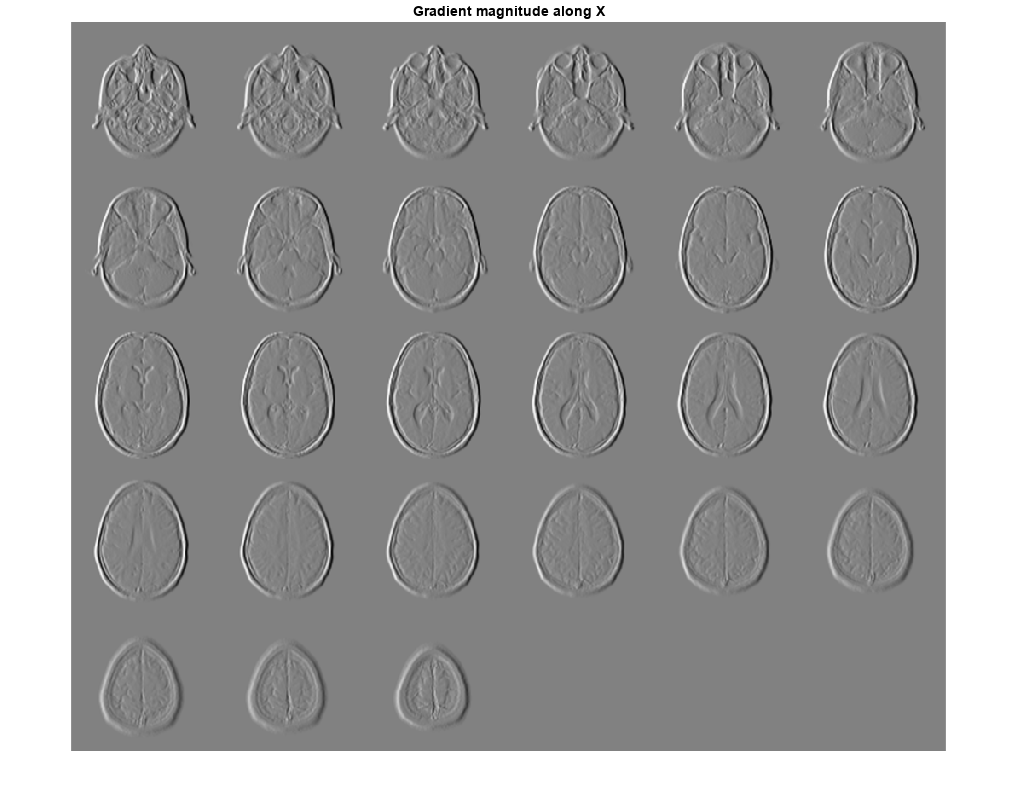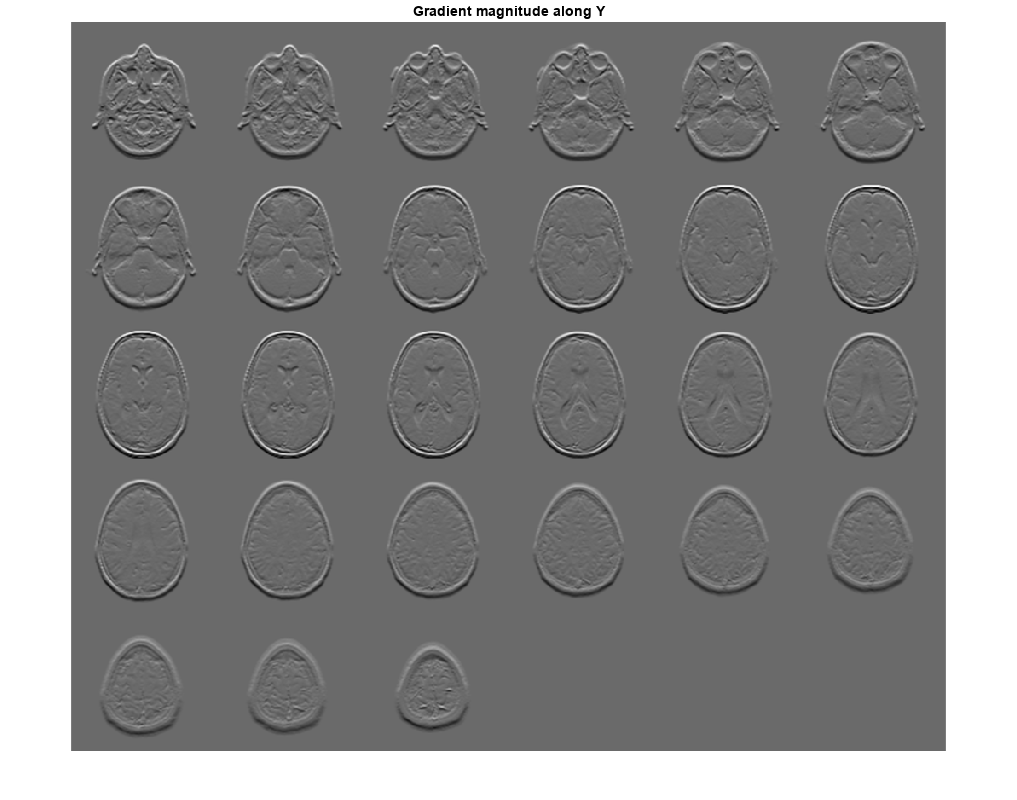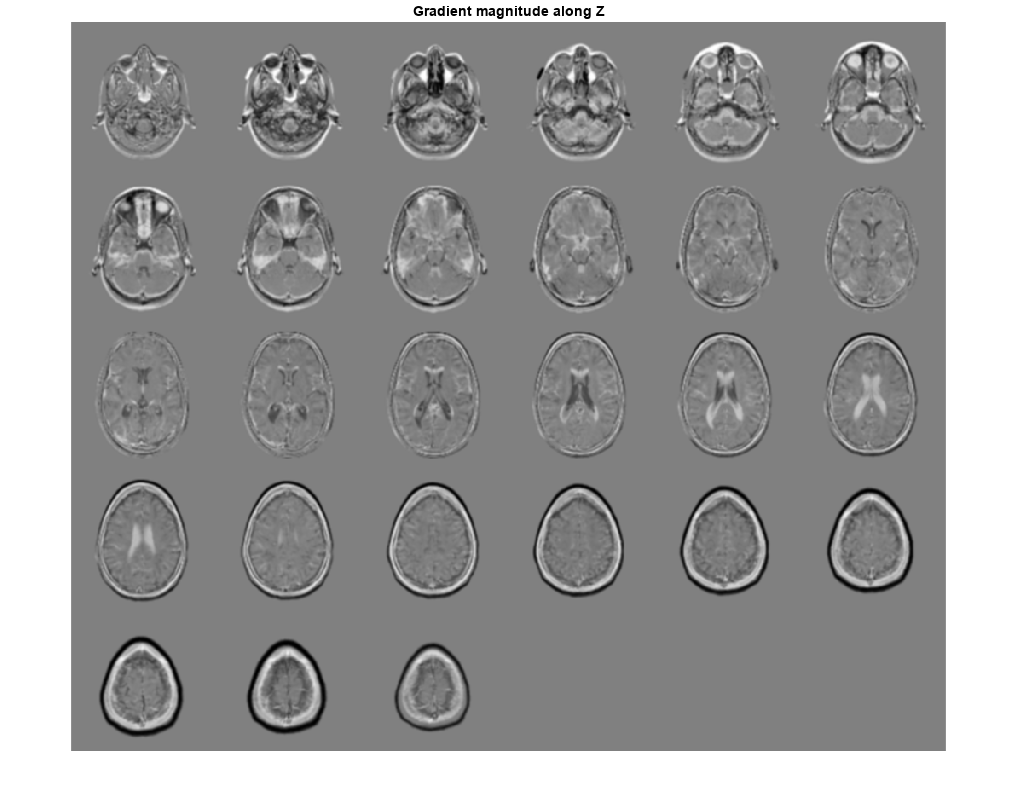imgradientxyz
Find directional gradients of 3-D image
Description
Examples
Read 3-D data and prepare it for processing.
volData = load('mri');
sz = volData.siz;
vol = squeeze(volData.D);Calculate the directional gradients.
[Gx, Gy, Gz] = imgradientxyz(vol);
Visualize the directional gradients as a montage.
figure, montage(reshape(Gx,sz(1),sz(2),1,sz(3)),'DisplayRange',[]) title('Gradient magnitude along X')

figure, montage(reshape(Gy,sz(1),sz(2),1,sz(3)),'DisplayRange',[]) title('Gradient magnitude along Y')

figure, montage(reshape(Gz,sz(1),sz(2),1,sz(3)),'DisplayRange',[]) title('Gradient magnitude along Z')

Input Arguments
Input image, specified as a 3-D grayscale image or 3-D binary image.
Data Types: single | double | int8 | int16 | int32 | int64 | uint8 | uint16 | uint32 | uint64 | logical
Gradient operator, specified as one of the following values.
Value | Meaning | ||||||
|---|---|---|---|---|---|---|---|
| Sobel gradient operator. The gradient of a pixel is a weighted sum of pixels in the 3-by-3-by-3 neighborhood. For example, in the depth (z) direction, the weights in the three planes are:
| ||||||
| Prewitt gradient operator. The gradient of a pixel is a weighted sum of pixels in the 3-by-3-by-3 neighborhood. For example, in the depth (z) direction, the weights in the three planes are:
| ||||||
"central" | Central difference gradient. The
gradient of a pixel is a weighted difference of
neighboring pixels. For example, in the depth
(z) direction, | ||||||
"intermediate" | Intermediate difference gradient. The
gradient of a pixel is the difference between an
adjacent pixel and the current pixel. For example,
in the depth (z) direction,
|
When applying the gradient operator at the boundaries of the image,
imgradientxyz assumes values
outside the bounds of the image are equal to the
nearest image border value. This behavior is similar
to the "replicate" boundary
option in imfilter.
Data Types: char | string
Output Arguments
Horizontal gradient, returned as a numeric matrix of
the same size as image I. The
horizontal (x) axis points in the
direction of increasing column subscripts.
Gx is of class
double, unless the input image
I is of class
single, in which case
Gx is of class
single.
Data Types: single | double
Vertical gradient, returned as a numeric matrix of the
same size as image I. The
vertical (y) axis points in the
direction of increasing row subscripts.
Gy is of class
double, unless the input image
I is of class
single, in which case
Gy is of class
single.
Data Types: single | double
Depth gradient, returned as a 3-D numeric array of the
same size as image I. The depth
(z) axis points in the
direction of increasing plane subscripts.
Gz is of class
double, unless the input image
I is of class
single, in which case
Gz is of class
single.
Algorithms
imgradientxyz does not normalize the gradient
output. If the range of the gradient output image has to match the
range of the input image, consider normalizing the gradient image,
depending on the method argument used. For example,
with a Sobel kernel, the normalization factor is 1/44, for Prewitt,
the normalization factor is 1/18.
Extended Capabilities
Usage notes and limitations:
imgradientxyzsupports the generation of C and C++ code (requires MATLAB® Coder™). For more information, see Code Generation for Image Processing.When generating code, the input argument
methodmust be a compile-time constant.
Usage notes and limitations:
When generating code, the input argument
methodmust be a compile-time constant.
Version History
Introduced in R2016a
See Also
MATLAB Command
You clicked a link that corresponds to this MATLAB command:
Run the command by entering it in the MATLAB Command Window. Web browsers do not support MATLAB commands.
选择网站
选择网站以获取翻译的可用内容,以及查看当地活动和优惠。根据您的位置,我们建议您选择:。
您也可以从以下列表中选择网站:
如何获得最佳网站性能
选择中国网站(中文或英文)以获得最佳网站性能。其他 MathWorks 国家/地区网站并未针对您所在位置的访问进行优化。
美洲
- América Latina (Español)
- Canada (English)
- United States (English)
欧洲
- Belgium (English)
- Denmark (English)
- Deutschland (Deutsch)
- España (Español)
- Finland (English)
- France (Français)
- Ireland (English)
- Italia (Italiano)
- Luxembourg (English)
- Netherlands (English)
- Norway (English)
- Österreich (Deutsch)
- Portugal (English)
- Sweden (English)
- Switzerland
- United Kingdom (English)